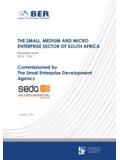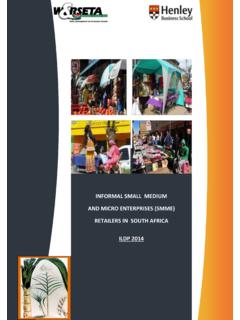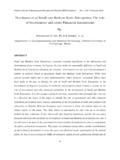Transcription of Development of Small and Medium Enterprises in the ASEAN ...
1 9. Development of Small and Medium Enterprises in the ASEAN Economies Yuri Sato Small and Medium Enterprises (SMEs) have been in the spotlight in ASEAN due to dramatic changes in East Asia's trade structures associ- ated with a massive intra-industry division of SMEs are seen as having significant potential to contribute to regional Development through participation in international production networks, or global value chains. Greater participation of SMEs in production networks through closer link- ages with multinational corporations (MNCs) is viewed as a potent means of accelerating SME upgrading in such areas as productivity, technology, and managerial This notion, however, requires reservations in at least two aspects. First, the contribution of the ASEAN SME sector to international production networks remains limited relative to its large size in terms of the number of establishments and its contribution to employment. The average SME. export share of five ASEAN member countries (Indonesia, Malaysia, the Philippines, Thailand, and Vietnam) is 23 percent, which is lower than that of their counterparts in other East Asian economies, where the export share of SMEs is 43 percent in Korea, 40 to 60 percent in China, and 56 percent in There thus seems to be considerable room for improvement in linking the ASEAN SME sector to international production networks.
2 Second, and more fundamentally, the ASEAN SME sector is character- ized by One extreme is those SMEs that are keen to improve productivity and innovative capabilities to meet the increased competition in the global market. In Singapore, more than 100,000 SMEs, which account for 70 percent of the total SMEs in the country, utilize business support programs organized by the governmental enterprise Development agency and Development of Small and Medium Enterprises in the ASEAN Economies | 155. The other extreme is those SMEs that dominate the SME sector in late-comer and populous ASEAN member countries. Most of them are micro in size and located in rural agrarian economies with limited access to markets and finance. An initial focus of SME Development in this case should be put on human resource Development to acquire basic managerial and financial skills. Given the trends toward economic integration in East Asia on the one hand and the heterogeneity of the ASEAN SME sector on the other hand, there are two Development pathways for ASEAN SMEs to take, as illus- trated in figure 1.
3 Figure 1. Framework of ASEAN SME Development : the competitive and dy- namic pathway and the inclusive pathway Source: by author, arranged from ERIA, The Jakarta Framework: Moving AEC Forward into 2015 and Beyond ( Jakarta: ERIA, 2011). SME Development is the backbone of the ASEAN Economic Community (AEC), which aims to enhance integration and competitiveness of ASEAN . economies. SME Development is also viewed as contributing to narrowing the Development gaps among the ASEAN economies. Development of SMEs is realized through capability upgrading. However, their processes of upgrading and the Development pathways they take to achieve the aim of the AEC are far from uniform, reflecting the wide spectrum of entities in the ASEAN SME sector . Development pathways are twofold. The first is the competitive and dynamic pathway, in which SMEs increase their 156 | BEYOND 2015. competitiveness through participation in production networks with MNCs or local large Enterprises .
4 The second is the inclusive pathway, in which SMEs upgrade their capabilities in tandem with local community develop- ment. The two Development pathways are not mutually exclusive, and SMEs in the inclusive pathway could have a chance to directly or indirectly take part in production networks. SME suppliers to MNCs in the competitive pathway could also utilize mechanisms of collective action emerging from local community Development , such as joint purchasing and order sharing. Government policy support can be broadly categorized into (1) direct support to facilitate SME capability upgrading, (2) indirect support to cre- ate institutional environments conducive for SME Development in both of the two pathways, and (3) establishment of the foundation of ASEAN to support more effective SME policymaking and implementation. With this framework in mind, this chapter reviews features of the ASEAN . SME sector , discusses tasks that ASEAN must undertake to address prob- lems in the sector , and attempts to identify possible areas of ASEAN -Japan cooperation in line with the mission to move the ASEAN Community forward to 2015 and beyond.
5 A S E A N Pol ic y B l u e p r i n t a n d A c t ion P l a n on S M E D e v e l op m e n t The ASEAN leaders have recognized SME Development as a vital element for the AEC to be a competitive and equitable economic region. That is why ASEAN has formulated SME-specific policies. In 2004, ASEAN drew up the ASEAN Policy Blueprint for SME Development 2004 2014. The blueprint aims to facilitate the emergence of an ASEAN SME sector that is entrepreneurial, innovative, outward-looking, competitive and It contains work plans, policy measures, and indicative outputs. In 2009, the sixth year of the 10-year blueprint, the ASEAN economic ministers (AEM) decided to develop the ASEAN Strategic Action Plan for SME Development 2010 2015 in order to accelerate the implementation of the blueprint. The Strategic Action Plan states its mission as follows: By 2015, ASEAN SMEs shall be world-class Enterprises , capable of integra- tion into the regional and global supply chains, able to take advantage of the benefits of ASEAN economic community building, and operating in a policy environment that is conducive to SME Development , exports and To realize that mission, the Strategic Action Plan set the following six goals: Development of Small and Medium Enterprises in the ASEAN Economies | 157.
6 Enhancing internationalization of SMEs and SME marketing capabilities Improving SME access to finance Strengthening SME human resource Development and capacity building Creating an incubator and promoting local SME Development Establishing an SME service center/ ASEAN SME service desk Setting up an ASEAN SME Regional Development Fund8. Under these goals, the specific plans, key activities, timeline, and respon- sible member countries were formulated into a policy matrix. Among the major deliverables are the following: A common curriculum for entrepreneurship in ASEAN . A comprehensive SME service center with regional and subregional linkages in ASEAN economies An SME financing facility in each ASEAN economy A regional program of internship schemes for staff exchanges and visits for skills training A regional SME Development fund to support intra- ASEAN business leaders In 2011, the ASEAN and East Asia Summits emphasized the role of SMEs as vehicles for accelerating intraregional trade, rebalancing the economies toward domestic and regional demand, and promoting inclusive growth in Asia.
7 As seen in the policy blueprint, the Strategic Action Plan, and other of- ficial statements, the ASEAN leaders seem to be fully aware of the necessity of competitive and innovative SMEs and have already outlined a wide range of challenges confronting ASEAN SMEs, as well as concrete actions to ad- dress those challenges. All these policies are ongoing, and there is no official progress report yet. Though progress might have been made to a certain extent in parts of ASEAN , generating an entrepreneurial, growth-oriented, outward-looking, modern and innovative and world-class SME sector in ASEAN remains a serious challenge given the current state of ASEAN . SMEs as described below. Cu r r e n t Sta t e of A S E A N S M E s A Variety of SME Definitions Table 1 compares official definitions and contributions of SMEs to the national economy in the 10 ASEAN member countries and Japan, based 158 | BEYOND 2015. on the latest official statistics and information from each governmental authority.
8 As seen in the table, a variety of official definitions of SMEs among the ASEAN countries is one of the major constraints to capturing a comprehensive picture of ASEAN SMEs. First, all the member countries use the number of workers per establish- ment as a common criterion, but cut-off lines between SMEs and large enter- prises vary from 100 to 300 persons. Only four countries adopt a definition of SMEs as Enterprises with fewer than 100 workers, which coincides with the standard Organisation for Economic Co-operation and Development (OECD) definition. Second, except for Brunei and Cambodia, all the countries use additional criteria such as assets excluding land and buildings, annual sales, investment, and capital, some of which vary by sector . Cut-off lines valued in terms of local currencies are revised every few years. Third, some countries do not have cut-off lines separating micro enter- prises from their SME category. Micro Enterprises , often defined as having fewer than five workers, are dominant in large parts of developing ASEAN .
9 Economies and typically operate in the informal sector without registering their status. Whether or not micro Enterprises are included significantly affects size structure, challenges, and policy implications. Contribution of SMEs to the National Economy Table 1 separates Small & Medium Enterprises , excluding micro establish- ments, and plus micro establishments, consisting of micro, Small , and Medium establishments, and it lists all available data on SMEs' shares in terms of the number of establishments, employment, and value added. The plus micro row is relatively complete. Interestingly, no obvious dif- ference is found between ASEAN countries and Japan in regard to SMEs'. dominance in the number of establishments and employment. The shares in Laos might possibly be underestimated partly due to a lack of formal reg- istration. It can be rather safely said that, in the ASEAN economies, SMEs including micro Enterprises account for 97 to percent of all Enterprises , and for 53 percent (Malaysia) to 97 percent (Indonesia) of employment, and contribute to 30 percent (Malaysia) to 58 percent (Indonesia) of GDP.
10 In each country. The Small & Medium row demonstrates the dearth of data facing the ASEAN SME sector , although this segment plays a key role in the com- petitive and dynamic pathway of SME Development (the right side of the framework in figure 1). Limited data indicate that the contribution of SMEs Table 1. A comparison of official deffinitions of SME and contribution to the national economy in the ASEAN countries and Japan Brunei Cambodia Indonesia Laos Malaysia Myanmar Philippines Singapore Thailand Viet Nam Japan Official Definition No. of workers 100 200 100 100 150 100 200 200 200 300 300. Other criteria Assets Assets Sales Horsepower Assets Assets Assets Capital Capital Sales Sales Investment Local Sales ownership Small & Medium Establishments 3,898 45,541 646,475 - 148,678 3,620 73,509 - - 57,700 1,465,001. (% of total) 44% 12% 1% - 23% 3% 9% - - 2% 25%. Employment - 31% 7% 27% 34% - 33% - - 25% 52%. Value added - - 23% - 23% - - - 55% 54%. Plus Micro Establishments 8,632 376,069 55,206,444 190,002 645,136 108,491 816,759 161,000 2,274,525 2,718,139 5,795,161.









